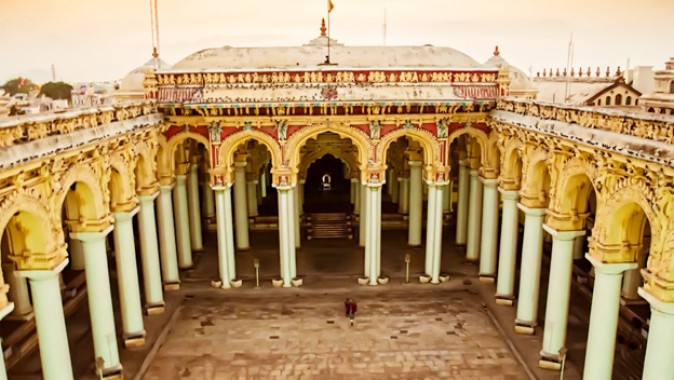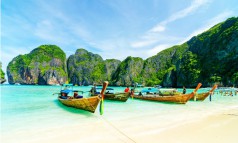




















Sunday, Feb 28, 2021 08:30 [IST]
Last Update: Sunday, Feb 28, 2021 03:01 [IST]
Watching the song sequence of “Kehna hi kya” in the 1995 Hindi movie ‘Bombay’, one was struck by the massive pillars of a beautiful palace and wondered where it was. This palace with countless massive pillars is in the Temple City of Madurai in southern Tamil Nadu. Known as ‘Thirumalai Nayakar Mahal’ after the king who built it, or more popularly just as ‘Mahal’, the palace was planned by an Italian architect in 1636 in a beautiful combination of Dravidian and Rajput/Rajasthani (or broadly Indo-Saracenic) style.
Originally four times its present size, now only the entrance, audience chamber and a few other structures have survived. Sadly, this grand palace was deprived of much of its beauty by the very grandson of Thirumalai Nayakar/Naicker when he shifted the capital to Thiruchirappalli (Trichy) to build his palace there, which never materialised. The then Governor of Madras, Lord Napier (1866-72), partially restored the palace and further restoration works were taken up in stages.
We step into a vast central courtyard of 42,000 sq. ft. surrounded by corridors/arcades with massive pillars and decorated arches connecting them. The striking white pillars measure 20 m (66 ft.) with a circumference of 4 m (13 ft.) that one person can’t hug lovingly! There are also massive shiny black stone pillars and ochre red pillars of varying heights. The rows and rows of pillars and the connecting arches hold the imposing structure together that is famous for foliated brickwork and stuccowork on domes, arches, pillars, ribs and wings. The so smooth and shiny texture on walls/pillars is a result of right combination of shell lime and egg white, a traditional building skill. While the first look is impressive because of the massive pillars, the Mahal’s interior is equally amazing with intricate paintings and sculptures (stuccowork), especially on the ceiling and dome’s interior as well. Big and also beautiful, the Mahal was then considered one among South India’s Wonders.
Mahal was basically designed into two sections as Swarga Vilasam and Ranga Vilasam. Swarga Vilasam or the Celestial Pavilion (75mx52m) was the King’s court. The marvel of this audience chamber is that no rafter/girder has been used in this brick-and-mortar hall, the arcades of which are 12m high. A 70ft. octagonal dome with catchy paint work in its ceiling is another attraction here. What exist now besides Swarga Vilasam are pooja room, queens’ chamber, auditorium, and bedroom. Ranga Vilas has disappeared from the scene. The whole complex measures 900’x660’ and had 22’ high wall guarding it.
Nayaks/Naicks were actually governors appointed by Vijayanagar kings for better management of captured territories. Madurai fell to Vijayanagar dynasty of Hampi in 1371 and the appointed Nayaks were obediently paying the annual fee. When the mighty Krishna Deva Raya king of Vijayanagar Empire died in 1530, the Nayaks assumed power. Among Nayak Kings, Madurai’s Thirumalai Nayakar (reign 1623-1659) was most popular.
I have historical connection with Mahal. In Madurai city, fat/chubby people were nicknamed ‘Mahal Thoon’ (Pillar). Though I wasn’t actually that fat my classmates called me ‘Thoon 2’; maybe they were leaner and also meaner. Thoon 1 was Cow (‘Gau’tham); naturally, Thoon 1 & 2 had good affinity! Curious to see the real ‘thoon’, I once peeked into Mahal then occupied by some government offices and what a mess it was! Open 9-5, Mahal has Light & Sound shows in English & Tamil. The Pillars have acted in several other movies also without moving an inch from their respective position. Come and give a warm hug to Mahal’s Thoons along with AR Rahman’s tunes!
(krishnanbala2004@yahoo.co.in / 9840917608 Whatsapp)
